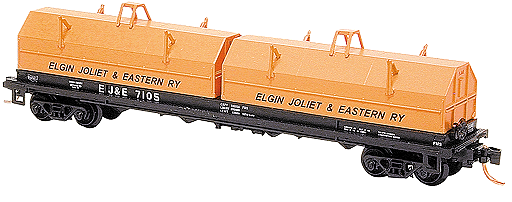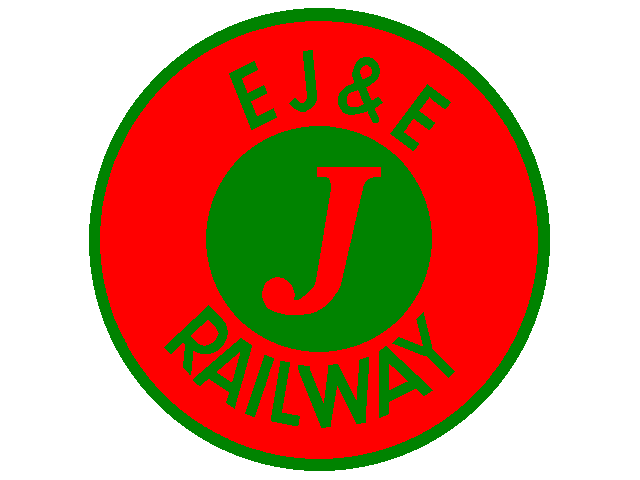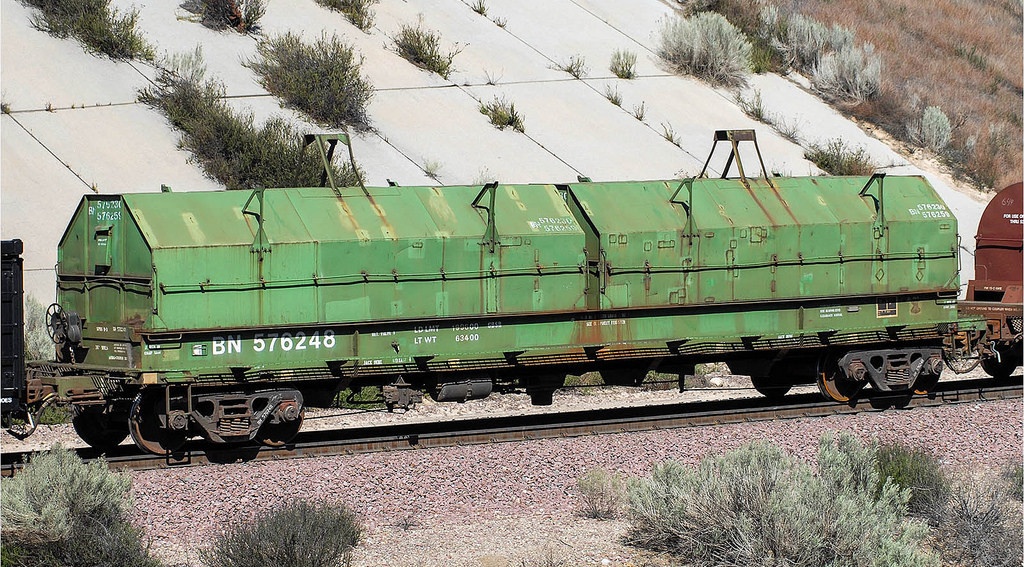Model Information: These models are both wonderful and awful at the same time. They have wonderful detail and printing, but the "RTR" versions are not.
They model an Evans 100-Ton Type-4 Steel Coil gondola car, and they do a pretty nice job. They show better underframe detailing than most Red Caboose models and the flexibility to run them with or without covers is nice, as long as you get the kit form.
Unfortunately if you get the Ready-To-Run (RTR) version, you don't get coils. And they are not truly Ready-to-Run because since they come with the covers glued to the Gondola, you are required to glue on the roof details or they will look wrong. Furthermore the roof details come on tiny sprues that need to be carefully cut apart. Then the attachment points where the details come away from the sprues need to be shaved. Then trying to glue these parts onto the coil covers is a feat worthy of neurosurgeon level dexterity or glue will get all over the covers.
Get the kit version if you can. You get the coils. You have to do the hardest part of the assembly job either way, and if you run them with the coils exposed, then you do not need to bother gluing the ding-dang roof details on the covers anyway.
They model an Evans 100-Ton Type-4 Steel Coil gondola car, and they do a pretty nice job. They show better underframe detailing than most Red Caboose models and the flexibility to run them with or without covers is nice, as long as you get the kit form.
Unfortunately if you get the Ready-To-Run (RTR) version, you don't get coils. And they are not truly Ready-to-Run because since they come with the covers glued to the Gondola, you are required to glue on the roof details or they will look wrong. Furthermore the roof details come on tiny sprues that need to be carefully cut apart. Then the attachment points where the details come away from the sprues need to be shaved. Then trying to glue these parts onto the coil covers is a feat worthy of neurosurgeon level dexterity or glue will get all over the covers.
Get the kit version if you can. You get the coils. You have to do the hardest part of the assembly job either way, and if you run them with the coils exposed, then you do not need to bother gluing the ding-dang roof details on the covers anyway.
Prototype History: The increased volume of coiled steel transportation gave rise to a new purpose-built freight car. Previously rolls of coiled-steel had generally traveled in specially equipped gondola cars. In the 1960s a lighter type of car emerged specifically for hauling coils of steel in an integral trough. The car type gained popularity and eventually over 17,000 cars were built. One common model was the 48 foot design from Evans.
The new commodity-specific coil-steel car were built with a 100-ton capacity using a trough frame and body. The early designs were refined during the 1960s and eventually Evans adopted a 48-foot length as standard. Production lasted well into the 1970s.
The new commodity-specific coil-steel car were built with a 100-ton capacity using a trough frame and body. The early designs were refined during the 1960s and eventually Evans adopted a 48-foot length as standard. Production lasted well into the 1970s.
Road Name History: The EJ&E dates from 1888. For most of its history, it was owned by US Steel whose Gary Works is near the east end of the line. Another company owns the mill now.
The EJ&E traces a wide arc around the Chicago area between 30 and 40 miles from the city center from Waukegan on the north, around Walker and Joliet, then east as far as Porter, Indiana. Because of this, the EJ&E was known for years as “The Chicago Outer Belt.” It also had the nickname, “The J”.
EJ&E’s two biggest missions have been moving steel and acting as a transfer road for all of Chicago’s Class 1’s and shortlines. As a result, the line was heavily trafficked with 100 locomotives required to serve just 230 route miles. In addition, EJ&E had over 10,000 freight cars, a huge fleet for a line that size.
In the early diesel days, EJ&E stuck mostly with Baldwin and EMD with a few Alco RS2’s thrown in. The J had more Baldwin center cab transfer engines (DT 6-6-2000) than anyone else, in fact more than just about everyone else combined. Ballasted EMD SD7’s painted in green over orange were also used in transfer service. EMD NW2’s were the primary switchers. In 1970, the Baldwins were replaced by EMD SD38-2’s, delivered with dual controls to they could just as easily run long hood forward. By that time, EJ&E had gone to solid orange with silver trucks and fuel tanks with various striping and logo placement variations over the years. They would also toy with gold and yellow and green and yellow schemes.
In 2009 the Elgin Joliet & Eastern was acquired by Canadian National in order to link their former Wisconsin Central, Illinois Central, Chicago Central & Pacific, and Grand Trunk Western lines. These lines approached the city from different directions and had required trackage rights and terminal roads to reach each other so acquiring the EJ&E was a logical move.
The EJ&E traces a wide arc around the Chicago area between 30 and 40 miles from the city center from Waukegan on the north, around Walker and Joliet, then east as far as Porter, Indiana. Because of this, the EJ&E was known for years as “The Chicago Outer Belt.” It also had the nickname, “The J”.
EJ&E’s two biggest missions have been moving steel and acting as a transfer road for all of Chicago’s Class 1’s and shortlines. As a result, the line was heavily trafficked with 100 locomotives required to serve just 230 route miles. In addition, EJ&E had over 10,000 freight cars, a huge fleet for a line that size.
In the early diesel days, EJ&E stuck mostly with Baldwin and EMD with a few Alco RS2’s thrown in. The J had more Baldwin center cab transfer engines (DT 6-6-2000) than anyone else, in fact more than just about everyone else combined. Ballasted EMD SD7’s painted in green over orange were also used in transfer service. EMD NW2’s were the primary switchers. In 1970, the Baldwins were replaced by EMD SD38-2’s, delivered with dual controls to they could just as easily run long hood forward. By that time, EJ&E had gone to solid orange with silver trucks and fuel tanks with various striping and logo placement variations over the years. They would also toy with gold and yellow and green and yellow schemes.
In 2009 the Elgin Joliet & Eastern was acquired by Canadian National in order to link their former Wisconsin Central, Illinois Central, Chicago Central & Pacific, and Grand Trunk Western lines. These lines approached the city from different directions and had required trackage rights and terminal roads to reach each other so acquiring the EJ&E was a logical move.
Brand/Importer Information:  Originally Red Caboose was a manufacturer of HO and N Scale model railroading items. It was located in Mead, Colorado, and was founded in 1990 by Leon Fairbanks.
Red Caboose manufactured highly accurate, well detailed N, HO, and O Scale freight cars and locomotives.
Originally Red Caboose was a manufacturer of HO and N Scale model railroading items. It was located in Mead, Colorado, and was founded in 1990 by Leon Fairbanks.
Red Caboose manufactured highly accurate, well detailed N, HO, and O Scale freight cars and locomotives.
Red Caboose closed its doors in January of 2015. Red Caboose N Scale has been sold to Fox Valley Models and HO was sold to InterMountain Railway. Many of the Red Caboose toolings have seen re-releases from Fox Valley since the acquisition. We just wish they would clean up the underframes. Red Caboose always went light on the details where they thought people wouldn't look.

Red Caboose closed its doors in January of 2015. Red Caboose N Scale has been sold to Fox Valley Models and HO was sold to InterMountain Railway. Many of the Red Caboose toolings have seen re-releases from Fox Valley since the acquisition. We just wish they would clean up the underframes. Red Caboose always went light on the details where they thought people wouldn't look.
Manufacturer Information: While they were in business, Red Caboose split its production runs between the US and China. Which models were produced where was a function of which body style and which run. Furthermore, which Chinese company was used for production is something we would love to find out.
Item created by: gdm on 2017-02-27 16:08:21. Last edited by baggedbird on 2022-09-24 20:44:14
If you see errors or missing data in this entry, please feel free to log in and edit it. Anyone with a Gmail account can log in instantly.
If you see errors or missing data in this entry, please feel free to log in and edit it. Anyone with a Gmail account can log in instantly.










